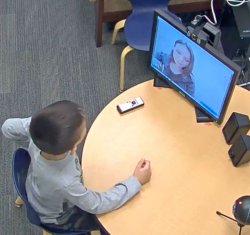Researchers Aid Child Witnesses With Tele-Forensic Interviewing
Remotely Interviewing children becomes more important as coronavirus spreads
Posted in: Education, Faculty Voices, Graduate School, Research, University

Given shelter-in-place orders and quarantines related to the COVID-19 outbreak, experts are expecting to see significant increases in child abuse cases as domestic violence rates rise in the coming weeks and months.
But how can professional child advocates protect the most vulnerable victims in a time of physical distancing?
Montclair State professors Jason Dickinson (Department of Psychology) and Nicole Lytle (Department of Social Work and Child Advocacy) are working to solve that problem.
As co-directors of the Talking Lab, Dickinson and Lytle have been working in conjunction with Debra Poole of Central Michigan University to finish a three-year study funded by the National Science Foundation on tele-forensic interviewing – a process that involves eliciting eyewitness testimony from children using tele-technology.
“Our original goal was to determine if this was an effective alternative to face-to-face interviewing when interviewers and children couldn’t connect because of geographic distances,” says Dickinson.
“Given the pandemic, our work has taken on a more pressing context and we’re now working with professionals from around the country on how to implement interviewing protocols using this technology,” adds Dickinson. “Protecting children and investigating claims of abuse has to go on, and right now the field is struggling with how to do that in a way that is safe and effective.”

Toward that end, Lytle, Dickinson and Poole quickly organized a March 20 conference call with approximately 500 Children’s Advocacy Centers (CACs), and national stakeholders including the FBI and Homeland Security Investigations, to discuss the legal, logistical, technical and other challenges with the goal of drafting policy on best practices.
Professionals shared their concerns, which ranged from broad questions to queries focusing on the smallest details. Topics included: ensuring that children are interviewed in a safe environment (e.g., not in the family home in an intrafamilial case); protecting the privacy of children; minimizing suggestive influences; and capturing the nuances of interviewing in a virtual environment. Practical concerns included choosing the best technology for recording and ensuring its authenticity, disinfecting the room where the child is being interviewed, and getting children and support staff to interview locations without exposing them to infection.
The group outlined recommendations in a document published by the National Children’s Alliance titled “Emergency Tele-Forensic Interview Guidelines.” This week, the guidelines were distributed to over 800 Children’s Advocacy Centers (CACs) nationwide.
“CACs are already behind in their interviews, so figuring out how to put these guidelines into play is pressing,” says Dickinson. “The guidelines may seem simple, but putting them into practice is enormously complex.”

Lytle adds, “Our study found that tele-interviewing does not reduce the quality or accuracy of children’s testimony, which provides legal cover for helping professionals as they start to conduct tele-forensic interviews. We’re fortunate that we had the study’s results in hand when the pandemic struck and were able to help translate the findings into practice.”
